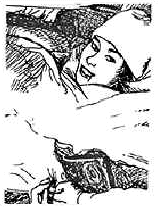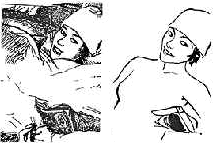


 What's wrong
with this picture?" That familiar refrain came to mind as I was reading the
paragraph, in Dr. Isadore Rosenfeld's August 16, 1998, Parade magazine article
about acupuncture, in which he describes an extraordinary Chinese operation witnessed by
him in the 1970s. That same question echoed upon my inspection of the accompanying picture
– a documentary photograph of that operation, taken by the author himself.
What's wrong
with this picture?" That familiar refrain came to mind as I was reading the
paragraph, in Dr. Isadore Rosenfeld's August 16, 1998, Parade magazine article
about acupuncture, in which he describes an extraordinary Chinese operation witnessed by
him in the 1970s. That same question echoed upon my inspection of the accompanying picture
– a documentary photograph of that operation, taken by the author himself.
Dr. Rosenfeld, a cardiologist and professor of medicine, has appeared on national TV talk/interview shows since the 1960s, and has authored several books, including the 1996 best-selling Dr. Rosenfeld's Guide to Alternative Medicine. Upon locating the book, I found a discussion of the operation in question on pages 30-32. My quotations herein are from the Parade article, the book, and several e-mail communications to me from Rosenfeld.
| Rosenfeld observed as "the surgeon ... cut through the ... breastbone with an electric buzz-saw [and] her chest was split in two [and] spread apart with a large clamp to expose the heart." |
Accompanied on his China trip by several other prominent American physicians (now deceased), the Rosenfeld party watched as a 28-year-old female patient was wheeled into an operating room at the University of Shanghai and prepped for heart surgery to repair her mitral valve. But in lieu of standard anesthesia, a practitioner placed "an acupuncture needle in her right earlobe" (per Parade), with an electrode attached to supply a mild electrical current.
Rosenfeld observed as "the surgeon ... cut through the ... breastbone with an electric buzz-saw [and] her chest was split in two [and] spread apart with a large clamp to expose the heart" (per his book). Rosenfeld shortly thereafter snapped the photograph that appears in Parade (it was not used in the book). Because Rosenfeld has denied me permission to reprint his photograph, TBS Report's Don Addis has faithfully reproduced its image, which is rotated 90 degrees counterclockwise (see sketch).
Only the patient's face and incision are visible through the gaps in the surgical sheets. Let us assume, as the photo appears to indicate, that her head is essentially "face up" as opposed to being significantly rotated right or left. (Her eyes are focused to her left, as if she is attempting to observe the operation but cannot rotate her head.) Drawing a vertical line down the midline of her body, the operative field appears to be displaced far to the patient's left, rather than being centered where the breastbone and heart are situated. In fact, it appears so far to the left as to exist beyond the border of the patient's body (see 2nd sketch by Don Addis). There does not appear to be any appreciable distortion in the photo such as might be encountered from the use of a wide-angle lens.
 Rosenfeld
says that this apparent leftward displacement "must be due to the angle at which [the
photo] was taken" (per e-mail to me). He teased me with the fact that one of the
others present (Dr. Wilbur Gould, ENT) had also taken photos and that his widow ". .
. no doubt has all his . . . pictures in her possession." But he would not assist me
in contacting her to obtain the photographs for review, saying that he did not wish to
"participate in your project to prove that my four colleagues and I did not see what
we saw."
Rosenfeld
says that this apparent leftward displacement "must be due to the angle at which [the
photo] was taken" (per e-mail to me). He teased me with the fact that one of the
others present (Dr. Wilbur Gould, ENT) had also taken photos and that his widow ". .
. no doubt has all his . . . pictures in her possession." But he would not assist me
in contacting her to obtain the photographs for review, saying that he did not wish to
"participate in your project to prove that my four colleagues and I did not see what
we saw."
In addition to the photographic oddities, I asked Dr. Rosenfeld how such surgery could have been performed without artificial ventilation: With the chest split open as described, the negative pressure produced by chest-wall expansion could not be created, the lungs would collapse, and the patient asphyxiate. I pointed out other problems as well, which are explored in a more extensive article on this matter that I have co-authored with Dr. Wallace Sampson, tentatively planned for publication in the Fall/Winter 1999 issue of The Scientific Review of Alternative Medicine.
I suggested to Dr. Rosenfeld that his party may have been taken in by a hoax perpetrated for propaganda purposes – a well-documented propensity of the Chinese during the Cold War. But Rosenfeld scoffed at the notion (as he does in his book), and suggested that I contact Dr. Michael DeBakey, one of the world's foremost cardiac surgeons, who "witnessed a similar procedure one year later [and] can explain your legitimate technical questions about ventilatory support. I spoke with him yesterday . . . " (per his e-mail). I asked Dr. Sampson to speak with DeBakey on our behalf, and the results of that interview were quite enlightening.
DeBakey informed Sampson that despite his conversation with Rosenfeld of just a few days earlier, he had neither read Rosenfeld's accounts of the operation nor seen his photograph, and he was thus unconversant with the precise details that were of concern to us. As for his own experience in China, DeBakey recalled that the mitral valve surgery that he had witnessed involved a patient who, it turned out, had been given pre-op medication intravenously prior to having the acupuncture administered. Additionally, DeBakey told Sampson that artificial ventilation had not been needed in the operation that he saw because it had been performed through an incision between two right ribs, thus sparing one (the left) lung. He added that, in his opinion, a midline, split-breastbone approach, such as described by Rosenfeld, would likely cause both lungs to collapse, just as we had suspected.
Before I knew of Dr. Sampson's own interest in this case, at about the time I was initiating my correspondence with Dr. Rosenfeld, Sampson had written to Parade editor Larry Smith (Rosenfeld is the magazine's health editor), pointing out some of the incongruities noted herein (and others) and asking how he might assist Parade in rectifying "the incorrect impressions given by the article." Sampson, a professor of medicine at Stanford University and editor in chief of The Scientific Review of Alternative Medicine, did not receive the courtesy of a reply.
A few additional observations are in order with regard to the precision of Dr. Rosenfeld's recollections and his attention to detail in recounting them. He acknowledged to me that, not being a surgeon, he actually "did not pay any particular attention at the time to the surgical technique used." He says in his book (contrary to the Parade version) that "needles" (plural) had been placed in the patient's "left" (not "right") earlobe. He explained to me that this "was a typo, which was not picked up since I did not use the photo" in the book. But the image was presumably indelibly imprinted in his mind. From the book: "I took a color photograph of that memorable scene: the open chest, the smiling patient, and the surgeon's hands holding her heart. I show it to anyone who scoffs at acupuncture." Yet, the photo clearly shows the surgeon's hands to the lower-left of the patient's heart – hardly another "typo."
Toward the end of our correspondence, Dr. Rosenfeld told me that, in publicizing the China story, his motivation had simply been "to draw attention to the possible use of acupuncture to alleviate chronic pain and suffering.... I thought acupuncture was worth looking into. I still do, as does a panel convened recently by the NIH.... I continue to keep an open mind on the subject." While I expressed my appreciation of that position, I also conveyed my concern that many of Parade's 80-plus-million readers could easily have drawn a conclusion that Rosenfeld says he did not intend – that acupuncture appears to possess mysterious and unexplained, perhaps even supernatural, anesthetic properties.
To this point about the important role that authorities such as Dr. Rosenfeld play in educating the American public on health-related issues, he replied, "As far as your fear that my readers will opt for acupuncture anesthesia during heart surgery, I think I can reassure you not to worry about it." Oh. Well, never mind, then.
Reprinted with permission from the Tampa Bay Skeptics Report, Vol. 11, No. 4, Spring 1999.